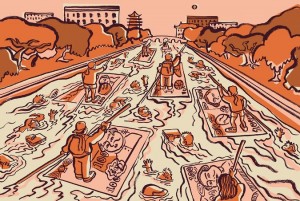By HELEN GAOSEPT. 4, 2014
Credit Dom McKenzie
BEIJING — Every September, the campuses of Peking and Tsinghua Universities, dubbed the Harvard and M.I.T. of China, brim with bright-eyed new students, the winners of China’s cutthroat education system. These young men and women possess the outlook of cosmopolitan youth worldwide: sporting designer clothes and wielding smartphones, they share experiences of foreign travel and bond over common fondness for Western television shows such as “The Big Bang Theory” and “Sherlock.”
They are destined for bright futures: In a few decades, they will fill high-powered positions in government and become executives in state banks and multinational companies. But their ever-expanding career possibilities belie the increasingly narrow slice of society they represent.
China’s state education system, which offers nine years of compulsory schooling and admits students to colleges strictly through exam scores, is often hailed abroad as a paradigm for educational equity. The impression is reinforced by Chinese students’ consistently stellar performance in international standardized tests. But this reputation is a myth.
While China has phenomenally expanded basic education for its people, quadrupling its output of college graduates in the past decade, it has also created a system that discriminates against its less wealthy and poorly connected citizens, thwarting social mobility at every step with bureaucratic and financial barriers.
A huge gap in educational opportunities between students from rural areas and those from cities is one of the main culprits. Some 60 million students in rural schools are “left-behind” children, cared for by their grandparents as their parents seek work in faraway cities. While many of their urban peers attend schools equipped with state-of-the-art facilities and well-trained teachers, rural students often huddle in decrepit school buildings and struggle to grasp advanced subjects such as English and chemistry amid a dearth of qualified instructors.

